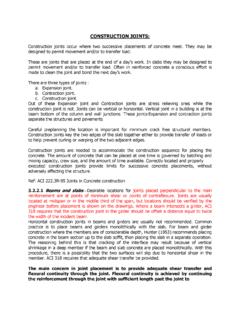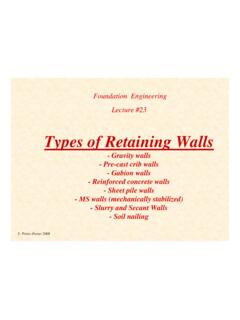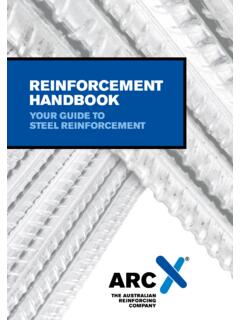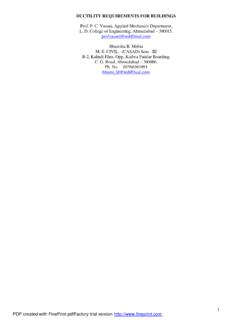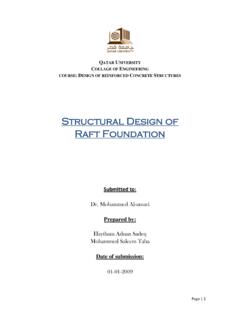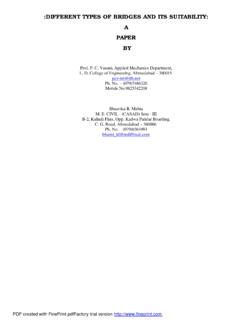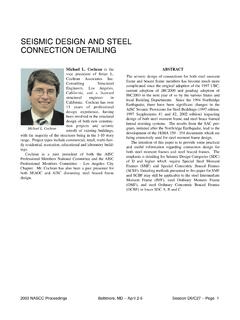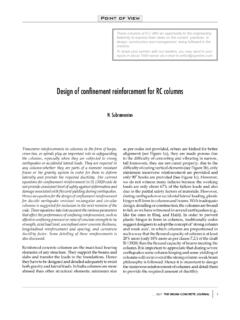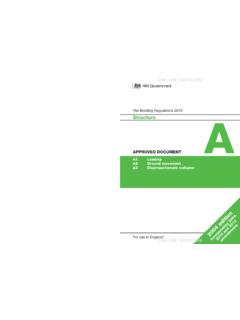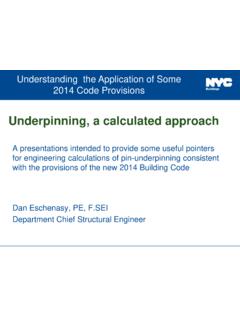Transcription of Offshore Structural Design - Structural Engineers
1 11 Offshore Structural DesignOffshore Structural DesignDetail EngineeringDetail EngineeringFixed PlatformsFixed of Fixed Platforms3 Design of structuresIn-place Phase (Piles, Jacket ,Deck Integral)Three types of analysis are performed: Survival state----- wave/current/wind attack with 50 or 100 years recurrence period. Operational state--- wave/current/wind attack with 1 or 5 years recurrence period, under full operation. Fatigue assessment for Design life. analyses are performed on the complete and intact structure. Assessments at damaged structures, with one member deleted, and assessments of collision situations are occasionally of structures(contd) Majority of Structural analyses are based on the linear theory of elasticity for total system behaviour.
2 Dynamic analysis is performed for the system behaviour under wave-attack if the natural period exceeds 3 seconds. 5 Structure GeometryJacket configuration depends of of : They areRisers , Boat Landing , Barge bumpersRiser guards, Pumps or Model Preparation- JacketsJacket structure shall be modelled as a 3D space frame. All primary and secondary tubular members shall be modelled. Risers & Caissons shall be modelled as Structural elements that attract wave loads (without contribution to the jacket stiffness). They should be linked to the jacket in a way that is consistent with their guide and anchor arrangements.
3 Conductors shall be modelled down to mudline level where they can be assumed pinned. Linear dependencies shall be provided at relevant guide levels such that conductors do not contribute to the Structural stiffness of the jacket. Boat landing primary members shall be modelled such that they attract wave loads. The effects of secondary members shall be considered by modelling additional masses and modifying the hydrodynamic coefficients of primary members. Boat landing models shall be connected to the jacket models such that they correctly reflect the state of the connection/releases between two Model Preparation- Jacket(contd.)
4 Jacket Appurtenances including mudmats, anodes, walkways, ladders and fenders shall be modelled as either Structural masses or increased density on associated members. The contribution of these members to hydrodynamic forces shall be considered by modifying drag and mass coefficients of main members Grouted pile sleeves and members with ring stiffeners shall be modelled as equivalent members with similar stiffness and correct Structural mass. Joint eccentricities shall be modelled based on the requirements of API-RP2A .8 Well Head Platform9 Codes and Standards API-RP2A: American Petroleum Institute Recommended practice for planning, designing and constructing fixed Offshore platforms The Structural Offshore code, Regulations of a major certifying authority.
5 DnV: Rules for the classification of fixed Offshore installations. AISC: Specification for the Design , fabrication and erection of Structural steel for buildings. American Institute of Steel Construction . Widely used Structural code AWS : Structural Welding Code - Welding Society 1990. The Structural Offshore welding code. Marine Operations: Standard for insurance warranty surveys in marine operations. Regulations of a major certifying authority. ABS: Rules for building and classing Offshore installations, Part 1 Bureau of Shipping of a major certifying authority.
6 BV: Rules and regulations for the construction and classification of Offshore platforms. Bureau Veritas Regulations of a major certifying water depth at location soil, at sea bottom and in-depth wind speed, air temperature waves, tide and storm surge, current ice (fixed, floes, icebergs) (not applicable for this part of world) Earthquakes Deck loads (Operating & Extreme) Dead loads, Live Loads, Equipment LoadsData Requirement11 Platform Data(Typical) Design life 25 yearsWind loads Inplace of Jacket ---- 1Hr averageDeck Inplace ---------- 1 Min AverageModules/Frame local- 3 Sec GustCantelever struct ----- 3 Sec GustZones.
7 Atmospheric ----- + upwardsSplash ----- to + ------ to MudlinePlat form location Northing Easting m from MSLL owest Astronomical Tide ----- Storm Parameters 13 Operating Storm Parameters14 Installation Parameters15 Envormental Parameters for Fatigue design16 Wave exceedance data (Fatigue Design )17 Design properties of steel shall be taken as follows: Density ( ) 7850 kg/m3 Modulus of Elasticity (E) 210 x 106 kN/m2 Shear Modulus (G) x 106 kN/m2 Poisson s Ratio ( ) Coefficient of Thermal Expansion ( ) x 10 6 / CMaterial Properties1819 Additional wall thickness in the form of corrosion allowance shall be provided for the jacket members in the splash zone Jacket legs, bracing, conductor and caissons 12mm Pipe casings and sump caissons (wrapped) 12mm wrapped plate Fenders, bumpers and boat landing members 6 mmNote.
8 The extra thickness for corrosion allowance shall not be included in calculating stresses in members or joints. For these members/joints, the allowance shall be deducted from the outside diameter of the tube. In general, the tubular member wall thickness in the splash zone shall not be less than 25mm. Alternatively Monel sheathing provided in Splash allowance20 Cathodic ProtectionAll jacket members below the water line shall be protected against corrosion usingsacrificial anodes. The protection system shall be designed based on the requirements of DNV-RP B401 Anode properties as per specification21 Loads The following loads shall be considered when a platform is in permanent condition: Dead Loads: Weight of the platform structure and appurtenances, permanent equipment and pipes, dead weight of modules, cranes and helideck.
9 Functional Loads: Loads induced by platform operation like weight of the liquids in pipes/tanks, thermal loads, drilling loads, loads induced by helicopter landing and vessel mooring, dynamic loads due to vibration of equipment and loads due to crane operation. Live Loads: Weight of the personnel, movable equipment and loads due to material handling. Environmental Loads: Loads induced by the action of waves, currents, winds, earthquake, and temperature fluctuations. Accidental Loads: Loads induced by accidental vessel collision, fire, explosion, wave slam and dropped Deck Loading23 Wind Load calculationsWind loads act on the portion of a platform above the water level, as well as on any equipment, housing, derrick, etc.
10 Located on the deck. An important parameter pertaining to wind data is the time interval over which wind speeds are averaged. For averaging intervals less than one minute, wind speeds are classified as gusts. For averaging intervals of one minute or longer they are classified as sustained wind wind velocity profile may be taken from API-RP2A [2]:Vh/VH = (h/H)1/n (1)where:Vh is the wind velocity at height h,VH is the wind velocity at reference height H, typically 10m above mean water level,1/n is 1/13 to 1/7, depending on the sea state, the distance from land and the averaging time interval.
